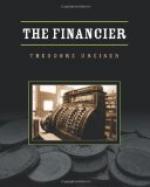“You needn’t worry about that, I think, Lillian,” he replied, buoyantly. “I’ll be all right.”
He ran down the steps and walked out on Girard Avenue to his former car line, where he bearded a car. He was thinking of Aileen and how keenly she was feeling for him, and what a mockery his married life now was, and whether he would face a sensible jury, and so on and so forth. If he didn’t—if he didn’t—this day was crucial!
He stepped off the car at Third and Market and hurried to his office. Steger was already there. “Well, Harper,” observed Cowperwood, courageously, “today’s the day.”
The Court of Quarter Sessions, Part I, where this trial was to take place, was held in famous Independence Hall, at Sixth and Chestnut Streets, which was at this time, as it had been for all of a century before, the center of local executive and judicial life. It was a low two-story building of red brick, with a white wooden central tower of old Dutch and English derivation, compounded of the square, the circle, and the octagon. The total structure consisted of a central portion and two T-shaped wings lying to the right and left, whose small, oval-topped old-fashioned windows and doors were set with those many-paned sashes so much admired by those who love what is known as Colonial architecture. Here, and in an addition known as State House Row (since torn down), which extended from the rear of the building toward Walnut Street, were located the offices of the mayor, the chief of police, the city treasurer, the chambers of council, and all the other important and executive offices of the city, together with the four branches of Quarter Sessions, which sat to hear the growing docket of criminal cases. The mammoth city hall which was subsequently completed at Broad and Market Streets was then building.
An attempt had been made to improve the reasonably large courtrooms by putting in them raised platforms of dark walnut surmounted by large, dark walnut desks, behind which the judges sat; but the attempt was not very successful. The desks, jury-boxes, and railings generally were made too large, and so the general effect was one of disproportion. A cream-colored wall had been thought the appropriate thing to go with black walnut furniture, but time and dust had made the combination dreary. There were no pictures or ornaments of any kind, save the stalky, over-elaborated gas-brackets which stood on his honor’s desk, and the single swinging chandelier suspended from the center of the ceiling. Fat bailiffs and court officers, concerned only in holding their workless jobs, did not add anything to the spirit of the scene. Two of them in the particular court in which this trial was held contended hourly as to which should hand the judge a glass of water. One preceded his honor like a fat, stuffy, dusty majordomo to and from his dressing-room. His business was to call loudly, when the latter entered, “His honor the Court,




